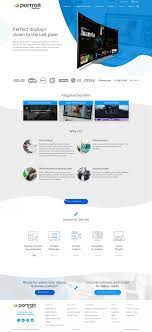Web Designer vs. Web Developer: Understanding the Differences
In the world of web development, two key roles often come into play: web designer and web developer. While these roles may seem similar at first glance, they actually involve distinct skill sets and responsibilities. Let’s delve into the differences between a web designer and a web developer to gain a better understanding of each role.
Web Designer:
A web designer is primarily responsible for the visual aesthetics of a website. They focus on creating an engaging and user-friendly design that enhances the overall user experience. Web designers use tools like Adobe Photoshop, Sketch, or Figma to create mockups and wireframes of websites before they are developed.
Key Responsibilities of a Web Designer:
– Creating visually appealing layouts and designs for websites
– Selecting color schemes, fonts, and images that align with the brand’s identity
– Ensuring that the website’s design is responsive and accessible across different devices
– Collaborating with clients to understand their design preferences and requirements
Web Developer:
On the other hand, a web developer is tasked with bringing the web designer’s vision to life through coding. Web developers use programming languages such as HTML, CSS, JavaScript, and PHP to build functional websites that are interactive and dynamic. They are responsible for implementing features like navigation menus, forms, animations, and more.
Key Responsibilities of a Web Developer:
– Writing clean and efficient code to build websites based on approved designs
– Ensuring that websites are optimized for speed, performance, and security
– Testing websites across various browsers and devices to ensure compatibility
– Troubleshooting technical issues and bugs that may arise during development
While web designers focus on creating visually appealing designs, web developers concentrate on turning those designs into functional websites through coding. Both roles are essential in the web development process, working collaboratively to deliver high-quality websites that meet clients’ needs.
In conclusion, understanding the distinctions between a web designer and a web developer is crucial for anyone looking to pursue a career in web development or hire professionals for their website projects. By recognizing the unique skill sets and responsibilities of each role, individuals can make informed decisions when it comes to building successful websites.
Six Essential Tips for Web Designers and Developers: Staying Current, Coding Practice, Responsive Design, User Experience, Collaboration, and Performance Optimization
- Stay updated on the latest web design and development trends.
- Practice coding regularly to improve your skills.
- Create responsive designs that work well on all devices.
- Pay attention to user experience and usability when designing websites.
- Collaborate with clients and team members to ensure project success.
- Optimize website performance for faster loading speeds.
Stay updated on the latest web design and development trends.
To excel as a web designer or developer, it is crucial to stay updated on the latest trends in web design and development. The digital landscape is constantly evolving, with new technologies, design techniques, and best practices emerging regularly. By keeping abreast of these trends, professionals can enhance their skills, deliver cutting-edge solutions to clients, and remain competitive in the industry. Continuous learning and adaptation to industry trends not only improve the quality of work but also demonstrate a commitment to innovation and excellence in web design and development.
Practice coding regularly to improve your skills.
To enhance your proficiency as a web designer or developer, it is essential to engage in regular coding practice. By consistently working on coding challenges, projects, or exercises, you can sharpen your skills, expand your knowledge of programming languages, and stay updated on industry trends. Practicing coding regularly not only helps you become more proficient in writing clean and efficient code but also boosts your problem-solving abilities and creativity when tackling web design and development tasks. Embracing a habit of consistent coding practice is key to continuous growth and improvement in the dynamic field of web design and development.
Create responsive designs that work well on all devices.
Creating responsive designs that work seamlessly across all devices is essential for web designers and developers. By prioritizing responsiveness, websites can provide a consistent user experience regardless of whether they are viewed on a desktop, laptop, tablet, or smartphone. This approach not only enhances usability but also improves accessibility and ensures that visitors can easily navigate and interact with the website no matter the device they are using. Embracing responsive design principles is key to meeting the diverse needs of users in today’s digital landscape.
Pay attention to user experience and usability when designing websites.
When it comes to web design and development, one crucial tip is to prioritize user experience and usability. Ensuring that a website is intuitive, easy to navigate, and visually appealing can significantly impact how users interact with the site. By focusing on creating a seamless and enjoyable experience for visitors, web designers and developers can enhance engagement, increase retention rates, and ultimately drive the success of the website. Paying attention to user experience and usability is key to creating websites that not only look great but also function effectively for users.
Collaborate with clients and team members to ensure project success.
Collaboration is key for web designers and developers to ensure project success. By working closely with clients to understand their requirements and preferences, as well as collaborating with team members to leverage each other’s expertise, professionals in these roles can create websites that not only meet the client’s needs but also exceed expectations. Effective communication and teamwork are essential in navigating the complexities of web development projects, leading to successful outcomes that benefit all stakeholders involved.
Optimize website performance for faster loading speeds.
One crucial tip for web designers and developers is to prioritize optimizing website performance to achieve faster loading speeds. By implementing best practices such as minimizing image sizes, leveraging browser caching, and reducing unnecessary code, you can significantly enhance the user experience. Faster loading speeds not only improve user satisfaction but also contribute to better search engine rankings and increased conversion rates. It is essential to continuously monitor and fine-tune website performance to ensure optimal speed and efficiency for visitors.




